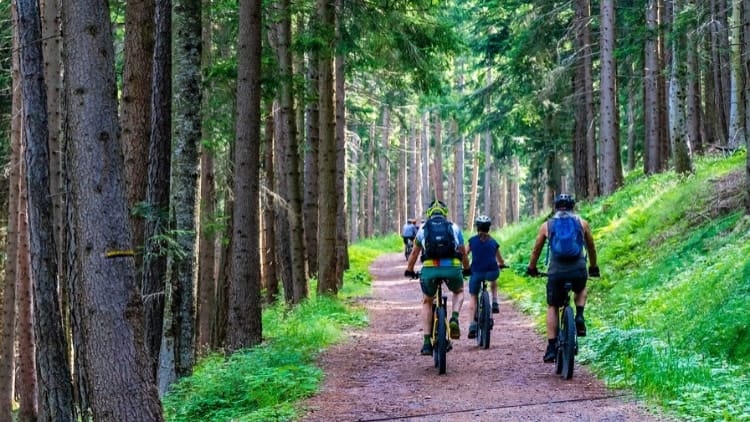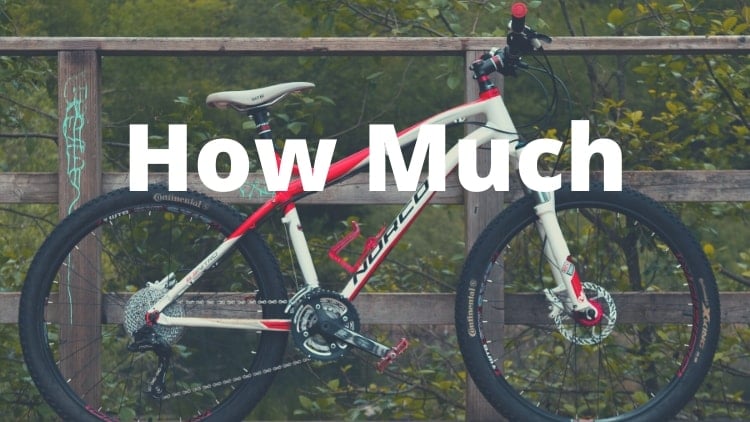Back when I first started Mountain Biking as a teen, I didn’t really care what I was riding.
In fact, the first bike I ever hit the trails with was an old Roadmaster 26er with balding tires and rear brakes only.
Of course… that bike didn’t last too long and before I knew it, it would be another few years before I would ever buy a new one.
Unfortunately, it was not until my adulthood that I would revisit Mountain Biking again, buying my first real Mountain Bike on my own.
And man-o-man, what a surprise I was in for.
When I first looked online at some of the prices that Mountain Bikes were going for, I could not believe my eyes.
Even looking for the “budget” model beginner bikes, I was hard-pressed to find a Mountain Bike under $1000.
My wife had just recently talked me down from buying a motorcycle, so you can guess how confident I was in telling her my intentions.
But I was prepared.
I knew I loved Mountain Biking, and I was willing to justify the investment, by any means possible – even if I had to do a PowerPoint and the whole nine yards to prove it.
Luckily, it never came to that point.
In fact, after a little bit of research, creativity, and patience, I was able to find a phenomenal Mountain Bike within my budget – and I’ve been riding it ever since.
During that process, I learned quite a bit about the market, as well as what to expect when buying a Mountain Bike.
For those of you wondering how much it costs or what you can expect to spend on a Mountain Bike, I created this guide.
By the end of this article, you will know how much a decent Mountain Bike costs, as well as some ways to keep your bike purchase within budget.
A decent Mountain Bike will cost anywhere between $400 and $800, however, there are many ways to save even more money on a quality bike. Although you can easily spend thousands on some of the newer Mountain Bikes, there are a lot of great options within a reasonable budget.
In this article, we will help you better understand the cost of a quality Mountain Bike, as well as some ways you can find it and save money. I also added a few topics that can give you a little guidance on getting started Mountain Biking.
Average Cost by Mountain Bike Type

Since Mountain Biking first gained traction in the 80’s, Mountain Bikes have really changed.
One of the most noticeable changes is the fact that there are so many different types of Mountain Bikes.
To better understand how much a decent Mountain Bike costs, you must first know the average cost for each type of Mountain Bike.
Although we still have the Hardtails we know and love, there are now more full suspensions than ever.
Even more, full suspensions have taken their category to a whole new level – introducing bikes like Downhill Bikes and All-Mountain Bikes.
Here is some pricing I pulled from the Major Mountain Bike manufacturers, listing the average cost for some of their Entry-level Mountain Bikes.
Entry Level Hardtail – $476

After reviewing all the entry-level Hardtails from over 9 of the top manufacturers, we found that the average cost for a decent Hardtail is $476.
Hardtails have been the leading type of Mountain Bike since Mountain Biking first started in the 80’s.
Unlike a full suspension, Hardtails have a rigid frame, with the only suspension being the front Forks.
Without that rear suspension, and the cost to support it, Hardtails are often the least expensive option when it comes to buying a Mountain Bike.
The benefit here is that manufacturers can focus on building a quality Mountain Bike, without worrying about reducing costs or skimping on quality.
This is a great reason to choose a Hardtail if you’re on a budget, as you will almost always get more bang for your buck.
For the same price as the most basic full-suspension Mountain Bike, you can get a fully decked-out Hardtail.
And trust me, the Hardtail is nothing to scoff at.
In fact, Hardtails are so capable, that they are still competing alongside the most advanced full suspensions on the market.
Entry Level Full Suspension – $1702

Again, we were able to review all the full-suspension bikes from over 9 top manufacturers, to find that the average cost for a decent full suspension Mountain Bike is $1702
When it comes to full suspension Mountain Bikes, the average pricing goes up by a substantial amount.
This is not only due to the cost of the additional suspension but also what it takes to make it safe to ride.
With full-suspension bikes, manufacturers have to completely redesign the bike frame.
They add pivot points, bearings, suspension, and numerous other points of potential failure that they must eliminate.
This is why the average full suspension costs so much, and why you want it to.
Entry Level Downhill – $4165

For Downhill bikes, we surveyed over 6 of the top manufacturers to find that a good Downhill Mountain Bike costs $4165 on the average
Technically, a Downhill bike is a type of Full suspension bike, however, they are so purpose-built that they really deserve their own category.
Although they are technically full-suspension bikes, Downhill Mountain Bikes will cost more, due to the stress they must withstand compared to most full-suspension bikes.
Downhill is a really extreme discipline of Mountain Biking.
Riders put their bikes under extreme stress on breakneck turns, jarring rock beds, and brutal drops.
In order to handle all of this, manufacturers have to build some of the strongest Mountain Bikes known to man.
On top of this, there is a lot of technology and research needed to innovate.
Entry Level Electric – $4595

After reviewing the entry-level Electric Mountain Bikes from over 7 manufacturers, it is concluded that the average E-MTB costs $4595.
E-MTBs are still relatively new and with novelty, comes cost.
And it’s not just the fact that they’re new, E-MTB’s are some really complex machines.
Similar to the Downhill bikes, an Electric Mountain Bike must be built to the strongest degree possible.
And often times, these Electric Mountain Bikes are very similar to their mechanical counterparts.
What Makes a Mountain Bike Good?

Now if you’re looking at new Mountain Bikes to gauge how much a decent one would cost; it’s going to appear very expensive.
Although those newer Mountain Bikes are cool, there is absolutely no obligation to buy the latest and greatest model available.
Yeah, they will have some of the latest trends and coolest gadgets, however, you can easily find a great Mountain Bike that is 10+ years old.
That was actually my case when I first got back into Mountain Biking.
Before I was going to spend, potentially, thousands of dollars on a new bike, I was going to prove to myself that I could stick with it.
So I bought a used Mountain Bike.
But I made sure to abide by certain criteria, as not all Mountain Bikes are made equal.
And this is one of the most important things to remember, as you don’t want to get the cheapest Mountain Bike possible.
So how do you know if a Mountain Bike is good or not?
It is actually really simple and easy.
At the bare minimum you know a Mountain Bike is good if it fits you well, has good brakes, and is structurally sound.
Once you make sure the bike is safe, you can start to pick preferences like gearing and suspension.
But I will break this down a little further to give you a better idea as to what makes a Mountain Bike good or not.
Fit
To start, you should always prioritize fit over anything else.
In fact, most riders would agree that a Proper Fitting is the best investment you could ever make when it comes to Mountain Biking.
This is because Fit plays a major role in the overall quality of your riding experience.
Fit affects how your bike handles and how confident you feel on your bike overall.
On top of this, you can even risk injury if you’re riding on a bike that fits badly, especially if you’re riding longer distances.
Frame Material
Material is the next thing to keep in mind when choosing your bike, as this will determine the overall strength of the Mountain Bike.
And trust me, when you’re hurling yourself down an MTB trail at 30 mph, you’re going to want to be able to trust that your bike will hold up.
When it comes to materials, you have a few options, with the most popular being; Aluminum, Steel, Carbon, and Titanium.
Aluminum – Aluminum is one of the most popular choices for frame material and for good reason. Through years of research and production, manufacturers have been able to use Aluminum to strike a balance between weight, strength, and affordability.
Steel – Steel is another frame material that is relatively strong and inexpensive, however, it can prove to be too heavy for most riders and is not the most efficient metal.
Carbon and Titanium – These two frame materials are often reserved for the more high-end Mountain Bikes. They offer superior strength for how lightweight they are, however, they are very expensive to make and buy.
If you’re looking for a decent Mountain Bike, try to stick to the standard Aluminum frames.
Not only are these some of the safest and strongest frames on the market, they are still relatively affordable.
The good news is that you’d be pretty hard-pressed to find anything else within your budget.
Gearing
Gearing has been an important argument in recent years.
Before the latest popularity of the 1X, Mountain Bikes used to come in gears ranging anywhere from 0 to 30.
This is where those 2 and 3 chainrings came in handy, as it would provide Mountain Bikers with a wide range of gears, aimed to handle just about any situation on the trail.
Up until recently, almost all of the Mountain Bikes sold came with 3 chainrings. And you would think this would be a premium feature.
However, with Mountain Bike components becoming even more efficient, more riders are seeking that expensive single chainring, also known as a 1X.
So do you need a Mountain Bike with a single chainring?
While it is definitely something to consider, it is far from a necessity.
In fact, there are a plethora of capable Mountain Bikes with the same old 3 chainring setup.
Depending on your budget, a 1X can be a worthwhile investment.
But if you’re looking for the best bang for your buck, don’t fret if your bike has 3 chainrings and excess gearing.
Brakes
Brakes are another safety feature to keep in mind when deciding on a Mountain Bike.
If you’ve noticed, a lot of the newer Mountain Bikes come with a disc brake setup.
Even some of the cheaper bikes, like the ones you see at Walmart, come with at least one-disc brake.
Brakes are also a performance feature; however, they are not a limiting factor.
So what makes disc brakes so much more popular than the standard rim brakes we’re used to and are they a necessity?
To start, disc brakes provide better grip when breaking and also allow for a wider range of modulation.
Even better, they are more reliable on the trail, even when it’s raining, full of mud, or too chunky to control.
But are disc brakes a necessity?
For most of us, the decades-old rim brake will still do the job. They have been a reliable braking method for all these years, and you can still find replacement parts left and right.
But you should still consider disc brakes when possible.
They have been around long enough that they’re becoming relatively inexpensive and common.
Even some of the more budget-friendly Mountain Bikes come with disc brakes.
Upgradability/Commonality
Two things that a lot of newer riders overlook when it comes to buying a Mountain Bike are Commonality and Upgradability.
As I mentioned before, Mountain Bikes are very durable, even some of the cheaper ones.
Whatever bike you buy, there is a good chance you will be sticking it out with it for years.
This means years of repairs, replacements, and even the occasional upgrade.
I didn’t really think about this when I bought a cheap department store Mountain Bike for my friend to ride.
After fixing up my legitimate Mountain Bike, I thought I would be pretty handy handling any repairs on this cheaper bike.
You can imagine my surprise when I found out how proprietary a lot of the cheap bike parts were. I often had trouble finding any tools to fit the non-standard bolts, even finding some parts completely welded together with no chance of upgrading.
On top of this, a lot of the replaceable assemblies were so generic, that there was no name or model to reference if I had to look something up.
Needless to say, we rode that bike till she conked out and tossed her.
The moral of the story is, to keep the long term in mind whenever you’re purchasing your Mountain Bike.
Once you fall in love with it, you are going to want to work on it and add premium features.
Any Mountain Bike worth its salt will be easily upgradable and replacement parts should be abundant and easily accessible.
Why do Mountain Bikes Cost So Much?

A huge argument you hear from the community is that you can buy a Motorcycle for the same amount of money that some Mountain Bikes cost.
And I can’t say that I would disagree.
Even doing the research for this article, I could see that a lot of the Mountain Bikes being advertised cost a lot more than the average person would budget.
And while I can definitely see the value in these expensive Mountain Bikes, they are often more appealing to avid riders.
For the average consumer, dropping a few thousand on a Mountain Biking can seem a bit excessive.
Especially when you can pick one up at your local Walmart for just over $100.
So what makes Mountain Bikes so expensive and are they really worth it?
To really answer this question, I will give a quick rundown of the variables that influence such a high price point, as well as some reasons they may be worth the extra cost.
They Don’t
When I first started looking into an upgraded Mountain Bike, I would always wonder what could explain such a wild price point.
After seeing all my dream bikes behind a thousand dollar pay wall, I used to wonder myself, “Why do Mountain Bikes cost so much?”.
What I eventually found out, was that Mountain Bikes don’t cost as much as you really think.
The real culprit to this way of thinking is the media and marketing companies pushing sales.
With all the advertisements aimed at the latest and greatest, you are led to believe that most Mountain Bikes are expensive.
But if you look at sales, as well as a lot of the bikes out on the trail, you will quickly see that affordable bikes rule the market.
In fact, manufacturers make the most profit on their entry-level Mountain Bikes, as the really expensive Mountain Bikes offer less margin.
Reliability
The next and most clear factor when it comes to how much Mountain bikes cost is their reliability.
As I mentioned before, Mountain Bikes are built for riders who put their bikes through the ringer – ripping them through corners, tearing them up down hills, and casing them jump after jump.
When you’re building a machine that can handle a Mountain Bike trail, reliability and durability are a must…at least when you’re avoiding a lawsuit.
Unlike the cheaper bikes you would see at department stores, the more expensive Mountain Bikes have gone through years and years of testing to prove their reliability.
And manufacturers are always working to improve their reliability.
As you can guess, the costs will increase as Mountain Bike becomes more resilient.
Evolution
The next thing to keep in mind when you’re considering the cost of a Mountain Bike is the years of innovation and evolution that have gone into the bike you’re riding.
Although there are a lot of similarities between the bikes of today and the bikes from 20 years ago, there are even more differences.
To start, modern Mountain Bikes are significantly more advanced than their decades-old counterparts.
Not only are there new and more efficient materials, there are also more efficient and complex manufacturing processes.
In order to keep up in an ever-changing market to supply the consumer, manufacturers have had to steadily increase the quality and value of their products.
Naturally, that cost will eventually find its way back to the consumer.
And although you can easily build a cheaper Mountain Bike, there is no way it would survive in the current market.
R&D
Finally, you have to give manufacturers credit for the years of research and Development they have put into their bikes.
As I said, any flaw, imperfection, or inconsistency in their product could result in a possible lawsuit…or even worse, a loss of consumers.
On top of the competition, consumer demand keeps manufacturers in the lab, researching new ways to deliver a better and more premium Mountain Bike than their competitors.
As you can guess, these costs aren’t cheap.
Not only do you have to hire the best and brightest in your field, you have to spend the time and manpower necessary to test and test every product.
And since Mountain Bikes are built to last years, those standards in quality are through the roof.
How to Save Money when buying a Mountain Bike

Although there are plenty of ways to justify the expensive cost associated with most Mountain Bikes, there are even more ways to save money when buying one.
In fact, I recommend that you always try to save money when buying a Mountain Biking.
Even if you have the budget to buy one of the more expensive bikes fresh off the press, in most cases, you will be better off saving money for future upgrades and repairs.
No matter where you are in regard to budget, here are 5 ways you can save money on a Mountain Bike.
1. Buy Last Season’s Models
Similar to cars, Mountain Bike manufacturers typically release new models every year.
And shortly after those newer models hit the showroom, the older models started seeing some significant price reductions.
This is especially true the longer it’s been since the new model dropped.
2. Buy Used from your LBS
When you first start Mountain Biking, you will quickly realize that your LBS is your central hub for all things MTB.
And not only do they keep the new models in stock, but they are also a great place to buy used Mountain Bikes.
Since they see bikes all day, they are often approached to buy or trade-in used Mountain Bikes.
Most of the time, these are older Mountain Bikes in really good condition.
I used to hop on my LBS’s website and see deals on Mountain bikes anywhere from $150 to $300.
3. Craigslist, VarageSale or Facebook Marketplace
If you have some patience and a keen eye, you will almost always find the best deals on a website like Craigslist or VarageSale.
Most of the Mountain Bikes you find on these sites have been sitting in storage for a few years or are too small or big for a grandson.
The result is that a lot of them will be in fairly decent shape.
And after a little elbow grease and frustration, you can have a really great bike on your hands for a steal of a price.
In fact, some of my best Mountain Bikes have come from VarageSale or similar.
Another great thing about this option is that the pricing is almost always negotiable, with some sellers even willing to trade for other goods.
Just be prepared to do a thorough inspection of the bike before buying and always know what you’re getting yourself into.
4. Buy a Budget Model
Though not really a secret but still relatively unknown, you always have the option to buy a budget model Mountain Bike.
For those of you looking for that brand-new bike but still wanting to stick to a budget, this is your best option.
Most of the time, the budget model Mountain Bikes are built on the same frame, with more budget-friendly components when it comes to the brakes, shifters, etc.
What this means, is that you can get a really capable machine that you can upgrade over time.
While the costs are high, this is one of the best options if you can afford it.
5. Wait for a Sale
Similar to the seasonal sales that manufacturers have, sometimes a Bike Shop will run a sale on the inventory they have in stock.
This a great option as the pricing will likely be more appealing than those seasonal sales, as the Bike Shop will be more encouraged to get rid of the excess inventory.
This is a good reason to check in with your LBS frequently and also try to visit their website if possible.
Do You Need to Buy an Expensive Mountain Bike?

Now this next one may get me a little flak but hear me out.
With some department stores selling Mountain Bikes just at and sometimes even below $100, it can seem wild being asked to drop 10 times that much on one of the “Real Mountain Bikes”.
Especially when real Mountain Bikes cost so much more all around.
But if you read a few of the points mentioned above in the article, you can clearly see why the expensive Mountain Bikes are worth the extra cost.
And with decent Mountain Bikes only costing a fraction more than those cheaper bikes, I would still recommend that you invest in a higher quality bike than what’s offered at your local Walmart.
But I cannot deny that those cheap department stores have a place.
In fact, I do not see a problem with a rider buying a department store Mountain Bike if it makes sense for them.
But there are a lot of flaws with department store bikes, so those who do buy from a department store need to know what they’re in for.
Especially since department store bikes are very unsafe on Mountain Bike trails.
To help you better decide if you need an expensive Mountain bike, I will offer the advice below.
When it’s okay to buy a Cheap Mountain Bike.
Again, department store bikes are often so unsafe, that I cannot recommend them for most riders. In fact, most are labeled so you do not take them out on an MTB trail.
However, there are definitely ways you can make them safer and even take them out on the trail.
It is okay to buy a cheap Mountain Bike if you’re sure you can make it safe to ride before taking it out on the trail. It is also okay to buy a cheap Mountain Bike if you only plan to ride on beginner trails that involve no jumps or extreme situations. Finally, cheap Mountain Bikes are a great option for those who just want to ride around their neighborhoods or local parks. Just be prepared for a loud and uncomfortable ride if you ride on anything too rough.
Since department store Mountain Bikes are made in the most cost-effective manner, they do not have the durability and safety you would expect with a serious Mountain Bike.
They do a good job of looking like the real thing but can be a real headache down the road.
When you need a more Expensive Mountain Bike.
The Mountain Bikes that are often labeled as expensive, are really just the bikes that are capable of safely riding on a Mountain Bike trail.
This is when it would make sense for you to invest in a more expensive Mountain Bike.
If you plan on riding real Mountain Bike trails, you really need the safety and reliability that comes with a more expensive Mountain Bike.
And as you can see, you can get a decent Mountain Bike for just about any budget.
How much does it Costs to go Mountain Biking?

Finally, a Mountain Bike is not the only thing you need to go Mountain Biking.
As you probably already know, Mountain Biking places a high priority on safety.
For this reason, you should never go Mountain Biking without having all the safety gear needed to ride.
At the bare minimum, you should make sure you have a Helmet, Gloves, appropriate shoes, and a basic first aid kit.
And if you apply the same principles I mentioned about saving on a Mountain Bike, you can also find a great deal on all the Mountain Bike Gear you need.
There are even places where you can rent a Mountain Bike if you’re not ready to buy.
To help you get a good idea as to what it costs to go Mountain Biking, I will break down a few of the things you can expect to pay for.
Mountain Bike – $300
Helmet – $30-50
Gloves – $15-30
Basic First Aid Kit – $10
Multi-Tool – $15
Spare Tubes – $10
Backpack or Hydration Pack* – $50-80
Cost to go Mountain Biking – $380
This list only mentions some of the more common costs, however, you may need to factor in the costs for Mountain Bike Park access, transportation, and things like repairs.
On top of that, there are ways to make this number even smaller by saving money on your Mountain Bike, buying used, or even renting a bike for the day.
Conclusion
In conclusion, a decent Mountain Bike does not cost that much.
In fact, there are many ways to save money on a Mountain Bike and even get started Mountain Biking on a budget.
I hope you found this article helpful.
Good luck finding your next Mountain Bike and safe riding!

